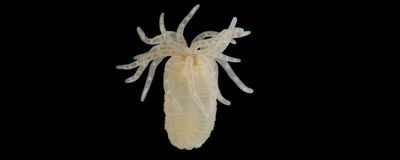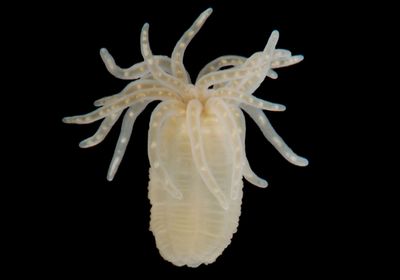ABOVE: Scientists found evidence of a population of stem cells that give rise to the gametes of the sea anemone Nematostella vectensis. Smithsonian Environmental Research Center; CC BY 2.0
In the freshwater polyp Hydra vulgaris, a single population of stem cells is responsible for both gamete production and the sea anemone’s impressive regenerative abilities. However, this productive stem cell population—interstitial stem cells (ISCs)— had only been identified in hydrozoans previously. Although other organisms of the Cnidaria phylum share the power of regeneration, the origin of their new cells remained a mystery.
Now, a research team at the University of Vienna discovered ISCs in another cnidarian species: the sea anemone Nematostella vectensis.1 Single-cell transcriptomics and transgenic reporter lines helped the researchers capture the unique population of cells. The findings, published in Science Advances, suggest that this group of cells likely emerged in a common cnidarian ancestor, rather than being an innovation specific to Hydra.
In Hydra, ISCs are noticeable: they are large and can be identified with simple microscopy. “Hydra is a bag of stem cells,” said Brigitte Galliot, a systems biologist at University of Geneva who was not involved with the study.
“We postulated that they must be [in other cnidarians], but we couldn't find them,” said Ulrich Technau, a developmental biologist and coauthor of the study. This led some researchers to suspect that developing and regenerated cells, such as neurons, originate from stem-like epithelial cells rather than ISCs. But Ulrich attributed the fact that they couldn’t find this population not to the lack of cells but rather to technical limitations. He and his team have now overcome these obstacles in their recent publication.
Technau and his team focused their investigations on the sea anemone N. vectensis because, like Hydra, these organisms have impressive regenerative capacities. The researchers started by running single-cell transcriptomics, focusing their efforts on identifying genes associated with a cluster of undifferentiated cells, which may contain stem cells. Examining the genetic profiles, they identified a set of genes, called nanos, associated with these undifferentiated cells. Nanos genes are known to be associated with stem cells in other organisms and are conserved across species, so Technau and his team considered these as potential molecular markers for a stem cell population in the sea anemones. In humans, the nanos gene family is restricted to the germline, but in Hydra, it is present in stem cells that give rise to somatic lineages.
To track and characterize the putative stem cells as they developed, the researchers used the promoter region of the nanos2 gene to drive expression of a fluorescent reporter protein.
Stem cells should be able to differentiate but also self-renew, dividing so they can continue providing a pool of cells for the organism. In their genetically-modified sea anemones, Ulrich and his team found that the putative nanos2-positive stem cells were slow cycling—dividing slowly—evidenced by prolonged expression of the DNA analogue EdU over the course of three months. “Having slow cycling cells is a very good argument to say they are stem cells,” said Galliot.
Their transgenic reporter lines also revealed that Nanos2 was expressed in both male and female reproductive organs of the sea anemone, as well as neuroglandular cell types. When the researchers knocked out the nanos2 gene using CRISPR/Cas9, they found that the animals lost the ability to produce gametes.
Finally, the team gathered enough evidence to identify the elusive ISC population. Finding these cells in Nematostella revealed important evolutionary insights: It suggested to the researchers that this population of stem cells is likely an evolutionarily conserved feature in Cnidarians.
“This is not an invention of Hydra, because Hydra and Nematostella, they're very far away from each other, like 500 million years,” said Technau. “That suggests that probably at the common ancestor of all Cnidarians they had already developed these stem cells.”
In contrast to Hydra, the nanos2 cells of the sea anemone were much smaller, round, and seemed to be more restricted in their potential to generate different cell types. For example, deleting nanos2 did not impact regeneration and did not result in a complete loss of neurons as Technau and his team had initially hoped. Technau suspects that other genes, such as nanos1, compensate for the loss of nanos2 in neuronal development. In the future, he plans to generate a double knockout to explore whether nanos1 plays a compensatory role for nanos2. This would reveal which stem cell populations and corresponding genes give rise to specific cell lineages.
Galliot said that the origin of the neuroglandular lineage remains an open question. “But, at least [the study] goes in a direction where there are more arguments to think that there could be the equivalent of interstitial stem cells that we find in hydrozoans.”
- Denner A, et al. Nanos2 marks precursors of somatic lineages and is required for germline formation in the sea anemone Nematostella vectensis. Sci Adv. 2024;10(33):eado0424.




